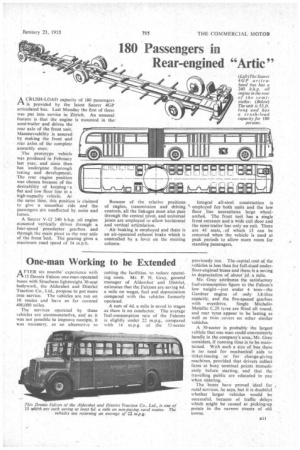One-man Working to be Extended
Page 45

If you've noticed an error in this article please click here to report it so we can fix it.
AFTER six months' experience with 15 Dennis Falcon one-man-operated buses with Strachans lightweight 30-seat bodywork, the Aldershot and District Traction Co., Ltd., propose to put more into service. The vehicles are run on 10 routes and have so far covered 400,000 miles.
The services operated by these vehicles are unremunerative, and as it was not possible to improve receipts; it was necessary, as an alternative to
cutting the facilities, to reduce operating costs. Mr. P. N. Gray, general manager of Aldershot and District, estimates that the Falcons are saving 6d. a mile on wages, fuel and depreciation compared with the vehicles formerly operated.
A sum of 4d. a mile is saved in wages as there is no conductor. The average fuel-consumption rate of the Falcons is slightly under 22 m.p.g., compared with 14 m.p.g. of he 32-seater previously run. The capital cost of the vehicles is less than for full-sized underlloor-engined buses and there is a saving in depreciation of about ltd. a mile.
Mr. Gray attributes the satisfactory fuel-consumption figure to the Falcon's low weight—just under 4 tons—the Gardner engine of only 3.8-litre capacity, and the five-speeed gearbox with overdrive. Single Michelin Metallic C.20 tyres are fitted all round, and rear tyres appear to be lasting as well as twin covers on other similar vehicles.
A 30-seater is probably the largest vehicle that one man could conveniently handle in the company's area, Mr. Gray considers, if running time is to be ma intamed. With such a size of bus there is no need for mechanical aids to ticket-issuing or for change-giving machines, provided that drivers collect fares at busy terminal points immediately before starting, and that the travelling public are educated to pay when entering.
The buses have proved ideal for rural services, he says, but it is doubtful whether larger vehicles would be successful, because of traffic delays which might be caused at picking-up points in the narrow streets of old towns.




























































































